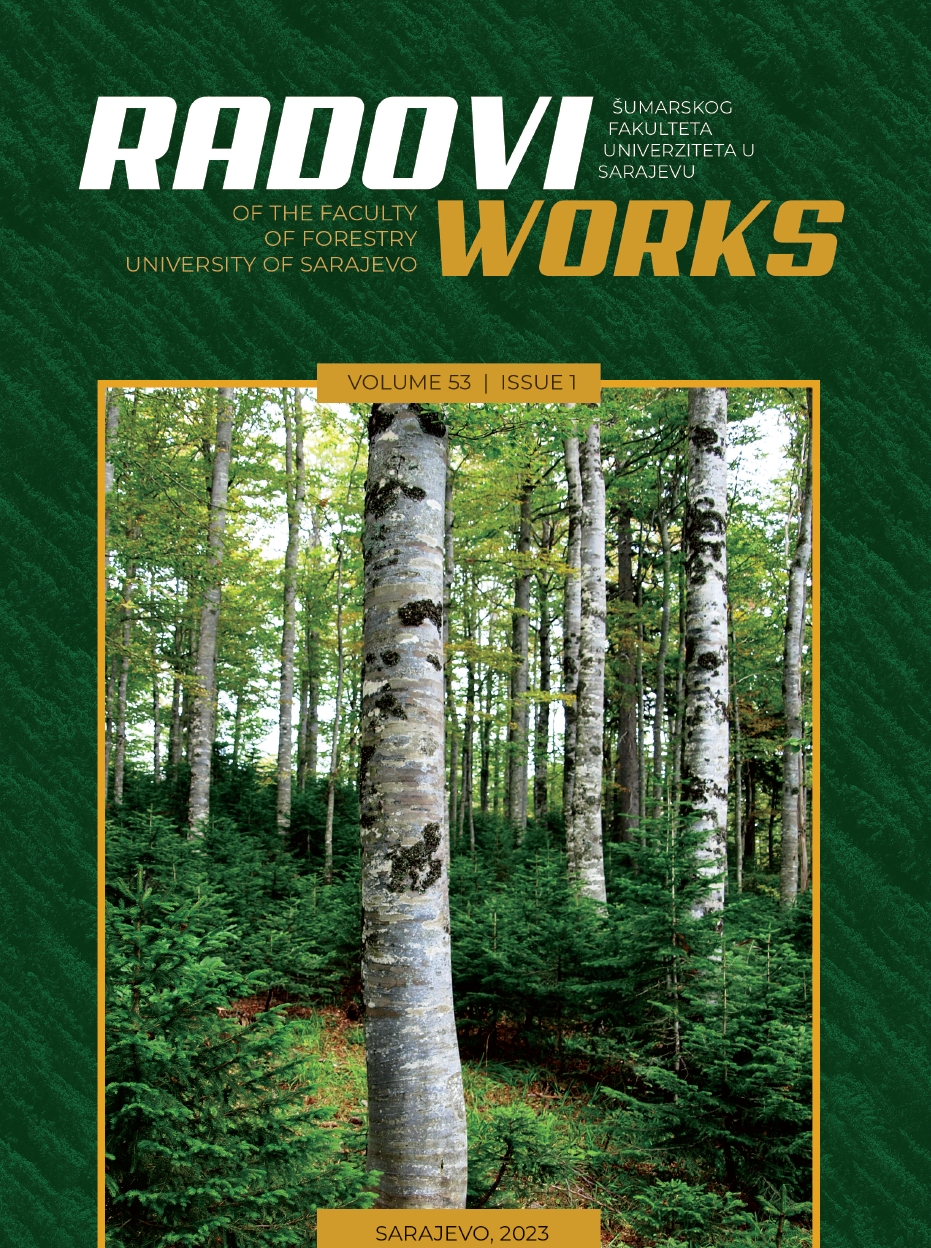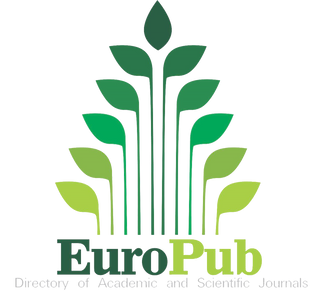Balkanska endemska vaskularna flora planine Konjuh
DOI:
https://doi.org/10.54652/rsf.2023.v53.i1.554Ključne riječi:
endemics, serpentinophytes, threatened taxa, flora, KonjuhSažetak
This paper presents data on the diversity and distribution of Balkan endemic vascular plants on the Konjuh Mountain in northeastern Bosnia and Herzegovina. Konjuh is characterized by geological heterogeneity and a significant proportion of ophiolitic substrate, which supports the development of endemic-relict serpentinophytes. A total of 31 endemic and four subendemic taxa were recorded in the surveyed area. Among these, Caryophyllaceae, with five recorded endemic taxa, is the most abundant family. The analysis of life forms and chorological spectra showed a dominance of hemicryptophytes and taxa from the South European and Mediterranean-Sub-Mediterranean chorological groups. The majority of endemic and relict taxa in the surveyed area are serpentinophytes. A total of 18 recorded taxa are listed as threatened according to the Red List of Flora of the Federation of Bosnia and Herzegovina. The species findings are presented with a distribution map. The distribution range of endemic and endangered taxa in Konjuh extends beyond the protected area. The results provide a list of locations of particular interest for further research and potential protection due to the diversity of endemic taxa.
Downloads
References
Babajić, E. (2009) Petrološko-geohemijska i geotektonska obilježja mafitnih magmatskih stijena Krivajsko-konjuškog ofiolitnog kompleksa. Doktorska disertacija. Rudarsko-geološko-građevinski fakultet Univerziteta u Tuzli.
Ballian, D., Šarić, Š. (2015) A new site for the Lilyleaf Ladybells (Adenophora liliifolia (L.) A.DC.) in Bosnia and Herzegovina. Glasnik Zemaljskog muzeja Bosne i Hercegovine u Sarajevu. 35: 61-64.
Bjelčić, Ž., Šilić, Č., Lakušić, R., Kutleša, Lj., Mišić, Lj. Grgić, P. (1969) Neke rijetke i interesantne vrste biljaka sa područja planina Maglića, Volujka i Zelengore. Posebna izdanja Odjeljenja prirodnih i matematičkih nauka ANUBiH, 3: 91-106. Sarajevo.
Bjelčić, Ž., Šilić, Č. (1971) Karakteristične cvjetnice za hercegovački endemni centar - planina Prenj, Čvrsnica i Čabulja. Glasnik Zemaljskog muzeja u Sarajevu, Prirodne nauke 10: 39-57.
Comitato internazionale per lo sviluppo dei popoli (CISP) (2019) Scientifico sulla biodiversità del paesaggio protetto Konjuh. Bosna i Hercegovina.
Đug, S., Muratović, E., Drešković, N., Boškailo, A., & Dudević, S. (2013) Crvena lista flore Federacije Bosne i Hercegovine. EU ''Greenway'', Sarajevo.
Euro+Med (2006) Euro+Med PlantBase - the information resource for Euro-Mediterranean plant diversity. Published on the Internet http://ww2.bgbm.org/EuroPlusMed/ [accessed 28th December 2022].
Enova (2017) Izvještaj o polaznoj osnovi stanja biodiverziteta zaštićenog pejzaža “Konjuh”. Public Institution Protected Landscape Konjuh. Bosnia and Herzegovina.
Franković, M., Kosec, D., Obratil, S., Đedović, R. (2002) Elaborat o proglašenju dijela područja planine Konjuh zaštićenim područjem. Zavod za zaštitu i korišćenje kulturno-istorijskog i prirodnog nasljeđa Tuzla.
Hafner, D., Cantonati, M. (2019) Algal assemblages in springs of different lithologies (ophiolites vs. limestone) of the Konjuh Mountain (Bosnia and Herzegovina). Acta Botanica Croatica 78(1): 66-81.
Halilaj, H., Kupe, L., Bajrami, A., Icka, P., Mala, X., & Damo, R. (2021) Endemic plants in the flora of Shutman (Sharri Mountain), Kosovo–an analysis of phytogeographical elements and life forms. Natura Croatica: Periodicum Musei Historiae Naturalis Croatici, 30(1), 1-11.
IUCN (2022) The IUCN Red List of Threatened Species. Version 2022-2. https://www.iucnredlist.org. Last Accessed on 6 January, 2023.
Kamberović, J., Plenković-Moraj, A., Kralj Borojević, K., Gligora Udovič, M., Žutinić, P.,
Kamberović, J. (2015) Struktura i sezonska dinamika krenonskih zajednica algi i vodenog bilja na području planine Konjuh. Doktorska disertacija. Univerzitet u Tuzli, Tuzla.
Kamberović, J. (2020) Ekosistemi izvora planine Konjuh. OFF-SET Štamparija Tuzla.
Kamberović, J., Adrović, A., Modrić, E., Lukić, Z., Nešković, R. (2020) The macrophyte flora and vegetation of the Paučko lake (mt. Konjuh). Works of the Faculty of Forestry University of Sarajevo 50(1): 4-11.
Kudumović Dostović, F. Ahmetbegović, S., Stjepić Srkalović, Ž. (2019) Climate as a development factor of recreational tourism in north-eastern Bosnia, Acta geographica Bosniae et Herzegovinae, 6 (11): 23-34.
Lampinen, R. (2001) Universal Transverse Mercator (UTM) and Military Grid Reference System (MGRS) [http://www.luomus.fi/english/botany/ afe/map/utm.htm]
Lakušić, R., Redžić, S. (1989) Flora i vegetacija vaskularnih biljaka u refugijalno-reliktnim ekosistemima kanjona rijeke Drine i njenih pritoka. Glasnik Odjeljenja prirodnih nauka Crnogorske akademije nauka i umjetnosti, Titograd. 7: 107-205.
Lubarda, B., Stupar, V., Milanović, Đ., Stevanović, V. (2014) Chorological characterization and distribution of the Balkan endemic vascular flora in Bosnia and Herzegovina. Botanica Serbica. 38(1): 167-1842.
Lubarda, B. (2019) Balkanski endemi u flori Bosne i Hercegovine. Univerzitet u Banjoj Luci. Prirodno-matematički fakultet, Banja Luka.
Maslo, S., Šarić, Š. (2021) Remarks on recent distribution of Polygonum albanicum Jáv. in Bosnia and Herzegovina. Glasilo Future 4 (5-6): 01–09.
Maslo, S., Šarić, Š., Niketić, M. (2022) Distribution of Balkan endemic Euphorbia serpentini. Natura Croatica 31(2): 251-263.
Nikolić T. (2020a): Flora Croatica – vaskularna flora Republike Hrvatske, Volumen 2. Ključevi za determinaciju s pratećim podatcima: Equisetidae, Lycopodiidae, Ophyoglossidae, Polypodidae, Cycadidae, Ginkgooidae, Gnetidae, Pinidae, Magnoliidae – porodice A – FAB. Alfa d. d., Zagreb.
Nikolić T. (2020b): Flora Croatica – vaskularna flora Republike Hrvatske, Volumen 3. Ključevi za determinaciju s pratećim podatcima: Magnoliidae – porodice FAG-ZYG. Alfa d. d., Zagreb
Nikolić, T., Milović, M., Bogdanović, S., Jasprica, N. (2015): Endemi u Hrvatskoj flori. Alfa d.d. Zagreb. Hrvatska.
Mueller-Dombois, D., Ellenberg, H. (1974) Aims and methods of vegetation ecology. New York, NY: John Wiley & Sons.
Pifkó, D. (2015) Index of scientific names of Chamaecytisus (Leguminosae) taxa. Studia botanica hungarica, 46(2), 175-203.
Pustahija, F. (2011) Odgovor genoma na abioticki stres : primjer serpentinofita u centralnoj Bosni. Agricultural sciences. Université Paris Sud - Paris XI; Univerzitet u Sarajevu, 2011. Bosnian. ffNNT : 2011PA112187
Pustahija, F., Brown, S.C., Bogunić, F., Bašić, N., Muratović, E., Ollier, S., Hidalgo, O.,
Bourge, M., Stevanović, V., Siljak-Yakovlev, S. (2013) Small genomes dominate in plants growing on serpentine soils in West Balkans, an exhaustive study of 8 habitats covering 308 taxa. Plant Soil 373, 427–453. https://doi.org/10.1007/s11104-013-1794-x.
Raunkiaer, C. (1934) The life forms of plants and statistical plant geography. London: Clarendon Press.
Redžić, S., Barudanović, S. Radević, M. (2008) Bosna i Herecgovina zemlja raznolikosti – pregled i stanje biološke i pejzažne raznolikosti BiH. Prvi izvještaj BiH za konvenciju o biološkoj raznolikosti. Federalno ministarstvo okoliša i turizma. Sarajevo.
Riter‐Studnička, H. (1963) Biljni pokrov na serpentinama u Bosni. Godišnjak Biološkog Instituta Univerziteta Sarajevo 14 (1–2): 91–204.
Ritter-Studnička, H. (1958) Bemerkenswerte Pflanzenfundeaus Bosnien und der Herzegowina. Plant systematics and evolution 105: 285-292
Ritter-Studnička, H. (1970) Die vegetation der Serpentinvorkommen in Bosnien. Vegetatio, 21(1/3), 75-156.
Ristić, P., Panić, Mudrinić, Likić (1967) Magmatizam i geohemizam planine Konjuh, Arhiv za tehnologiju, V, 3-4.
Official Gazette of the Federation of Bosnia and Herzegovina 07/14 (2014) Crvena lista divljih vrsta i podvrsta biljaka, životinja i gljiva.
Stevanović, V. (1996) Analysis of the Central European and Mediterranean orophytic element on the mountains of the W. and Central Balkan Peninsula, with special reference to endemics. Bocconea 5: 77-97.
Stevanović, V. (2005) Biodiversity estimation – from interpretation to conservation, example of endemic vascular flora of the Balkans. In: M. Anđelković (ed.) Biodiversity at the onset of the millennium, Scientific Meetings, BookCXI, Dept. of the Chemical and Biological Sciences, SASA, Book 2: 53-73.
Stevanović, V., Tan, K., Iatrou G. (2003) Distribution of the endemic Balkan flora on serpentine. I. Obligate serpentine endemics. Plant Systematics and Evolution 242: 149-170.
Stevanović V. (1992) Floristička podela teritorije Srbije sa pregledom viših horiona i odgovarajućih flornih elemenata. In: Sarić, M.R., (ed.) Flora Srbije, 1. Srpska akademija nauka i umetnosti, Beograd 47–56.
Stupar, V., Milanović, Đ., Brujić, J., Buzadžija, S., Travar, J. (2011) Ugroženi, rijetki i endemični taksoni područja Banja Luke. Skup 4 – Zbornik radova Drugog simpozijuma biologa i prvog simpozijum ekologa RS: 165-179. Prirodno-matematički fakultet. Banja Luka.
Šilić, Č. (1990) Endemične biljke. SP “SVJETLOST”, Zavod za udžbenike i nastavna sredstva, Sarajevo; Zavod za udžbenike i nastavna sredstva, Beograd.
Šilić, Č., Abadžić, S. (1986) Endemične biljne vrste u ekosistemima planina oko Sutjeske. Godišnjak Biološkog instituta Univerziteta u Sarajevu 39: 151-160.
Šilić, Č., Abadžić, S. (1991) Endemične biljne vrste Dinarida i mogućnost primjene nekih vrsta u hortikulturi. Glasnik Zemaljskog muzeja Bosne i Hercegovine u Sarajevu, Prirodne
nauke 30: 47-127.
Tomović, G., Niketić, M., Lakušić, D., Ranđelović, V., & Stevanović, V. (2014) Balkan endemic plants in Central Serbia and Kosovo regions: Distribution patterns, ecological characteristics, and centres of diversity. Botanical Journal of the Linnean Society, 176, 173– 202.
Turrill, W.B. (1929) The plant life of the Balkan peninsula. A phytogeographical study. Oxford: Clarendon Press.
Tutin, T.G., Heywood, V.H., Burges, N.A., Valentine D.H., Walters, S.M., Webb, D.A. /ed./ (1964-1993) Flora Europaea 1-5, Cambridge University Press, Cambridge.
Vuksanović S., Tomović G., Niketić M. & Stevanović V. (2016) Balkan endemic vascular plants of Montenegro – critical inventory with chorological and life-form analyses. – Willdenowia 46: 387 – 397. doi: http://dx.doi.org/10.3372/wi.46.46307























